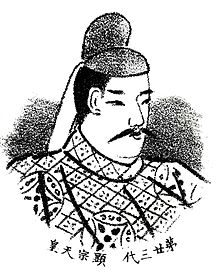Emperor Kenzō (顕宗天皇, Kenzō-tennō) (450 — 2 June 487) was the 23rd legendary emperor of Japan,[2] according to the traditional order of succession.[3]
| Emperor Kenzō 顕宗天皇 | |||||
|---|---|---|---|---|---|
 | |||||
| Emperor of Japan | |||||
| Reign | 1 February 485 – 2 June 487 (traditional)[1] | ||||
| Predecessor | Seinei (possibly Iitoyo) | ||||
| Successor | Ninken | ||||
| Born | 450 Japan | ||||
| Died | 2 June 487 (aged 36–37) Asuka, Yamato | ||||
| Burial | Kataoka no Iwatsuki no oka no minami no misasagi (傍丘磐坏丘南陵) (Nara) | ||||
| Spouse | Naniwa-no-Ono | ||||
| |||||
| House | Imperial House of Japan | ||||
| Father | Ichinobe no Oshiwa | ||||
| Mother | Wae-hime | ||||
No firm dates can be assigned to this emperor's life or reign, but he is conventionally considered to have reigned from 1 February 485 to 2 June 487.[4]
Legendary narrative edit
Prince Woke (袁祁王), later to become Emperor Kenzō, is said to have been the grandson of Emperor Richū, and the son of Ichinobe-no Oshiwa.[5] He would have been quite young when Emperor Yūryaku shot the arrow which killed his father during a hunting expedition; and this caused both Prince Woke and his older brother, Prince Oke, to flee for their lives. They found refuge at Akashi in Harima Province where they hid by living in obscurity. Histories from that period explained that the two brothers sought to blend into this rural community by posing as common herdsmen.[6]
It is said that the Oke came by chance to Akashi; and at that time, Prince Oke revealed his true identity. This intermediary re-introduced the lost cousins to Emperor Seinei, who had by this time ascended to the throne after the death of his father, the former Emperor Yūryaku. Seinei invited both brothers to return the court; and he adopted both of them as sons and heirs.[6]
At Seinei's death, he had no other heirs than Prince Oke and Prince Woke, whose father had been killed by Yūraku. At this point, Woke wanted his elder brother to become Emperor; but Oke refused. The two could not reach an agreement. The great men of the court insisted that one or the other of the brothers must accept the throne; but in the end, Woke proved to be more adamant. Prince Woke agreed to accept the throne; and Kenzō was ultimately proclaimed as the new Emperor—which created a sense of relief for all the people who had endured this period of uncertainty.[7]
Kenzō is considered to have ruled the country during the late-5th century, but there is a paucity of information about him. There is insufficient material available for further verification and study.
Kenzō's contemporary title would not have been tennō, as most historians believe this title was not introduced until the reigns of Emperor Tenmu and Empress Jitō. Rather, it was presumably Sumeramikoto or Amenoshita Shiroshimesu Ōkimi (治天下大王), meaning "the great king who rules all under heaven". Alternatively, Kenzō might have been referred to as ヤマト大王/大君 or the "Great King of Yamato".
Kenzō's reign edit
It is recorded that his capital was at Chikatsu Asuka no Yatsuri no Miya (近飛鳥八釣宮) in Yamato Province.[8] The location of the palace is thought to have been in present-day Osaka Prefecture or Nara Prefecture.[9]
Murray reports that the only event of major consequence during Kenzō's reign had to do with the filial respect he showed for his murdered father. Kenzō arranged to have his father's remains retrieved and re-interred in a mausoleum appropriate for the son of an Emperor and the father of another.[10]
Kenzō died at age 37, reigning only three years.[8] He too had no other heirs; so his brother would follow him on the throne. His Empress was Princess Naniwa-no-Ono (難波小野王, d.489), Prince Oka-no-Wakugo's daughter (also Prince Iwaki's granddaughter and Emperor Yuryaku's great-granddaughter).
The actual site of Kenzō's grave is not known.[2] The Emperor is traditionally venerated at a memorial Shinto shrine (misasagi) at Osaka.
The Imperial Household Agency designates this location as Kenzō's mausoleum. It is formally named Kataoka no Iwatsuki no oka no kita no misasagi.[11]
Consorts and children edit
Empress (Kōgō) : Princess Naniwa-no-Ono (難波小野王, d.489), Prince Oka-no-Wakugo's daughter (also Prince Iwaki's granddaughter and Emperor Yuryaku's great-granddaughter)
See also edit
Notes edit
- ^ "Genealogy of the Emperors of Japan" at Kunaicho.go.jp; retrieved 2013-8-29.
- ^ a b Imperial Household Agency (Kunaichō): 顕宗天皇 (23); retrieved 2013-8-29.
- ^ Titsingh, Isaac. (1834). Annales des empereurs du japon, pp. 29–30; Brown, Delmer M. (1979). Gukanshō, p. 259; Varley, H. Paul. (1980). Jinnō Shōtōki, p. 116.
- ^ Ponsonby-Fane, Richard. (1959). The Imperial House of Japan, p. 42.
- ^ Murray, David. (1906). Japan, p. 102., p. 102, at Google Books
- ^ a b Titsingh, p. 29.
- ^ Titsingh, pp. 29-30.
- ^ a b Titsingh, p. 30.
- ^ Aston, William. (1998). Nihongi, Vol. 1, pp. 377–393.
- ^ Murray, p. 103., p. 103, at Google Books
- ^ Ponsonby-Fane, p. 419.
References edit
- Aston, William George. (1896). Nihongi: Chronicles of Japan from the Earliest Times to A.D. 697. London: Kegan Paul, Trench, Trubner. OCLC 448337491
- Brown, Delmer M. and Ichirō Ishida, eds. (1979). Gukanshō: The Future and the Past. Berkeley: University of California Press. ISBN 978-0-520-03460-0; OCLC 251325323
- Murray, David. (1906). Japan. New York: G.P. Putnam & Sons. OCLC 52763776
- Ponsonby-Fane, Richard. (1959). The Imperial House of Japan. Kyoto: Ponsonby Memorial Society. OCLC 194887
- Titsingh, Isaac. (1834). Annales des empereurs du Japon (Nihon Ōdai Ichiran). Paris: Royal Asiatic Society, Oriental Translation Fund of Great Britain and Ireland. OCLC 5850691
- Varley, H. Paul. (1980). Jinnō Shōtōki: A Chronicle of Gods and Sovereigns. New York: Columbia University Press. ISBN 978-0-231-04940-5; OCLC 59145842